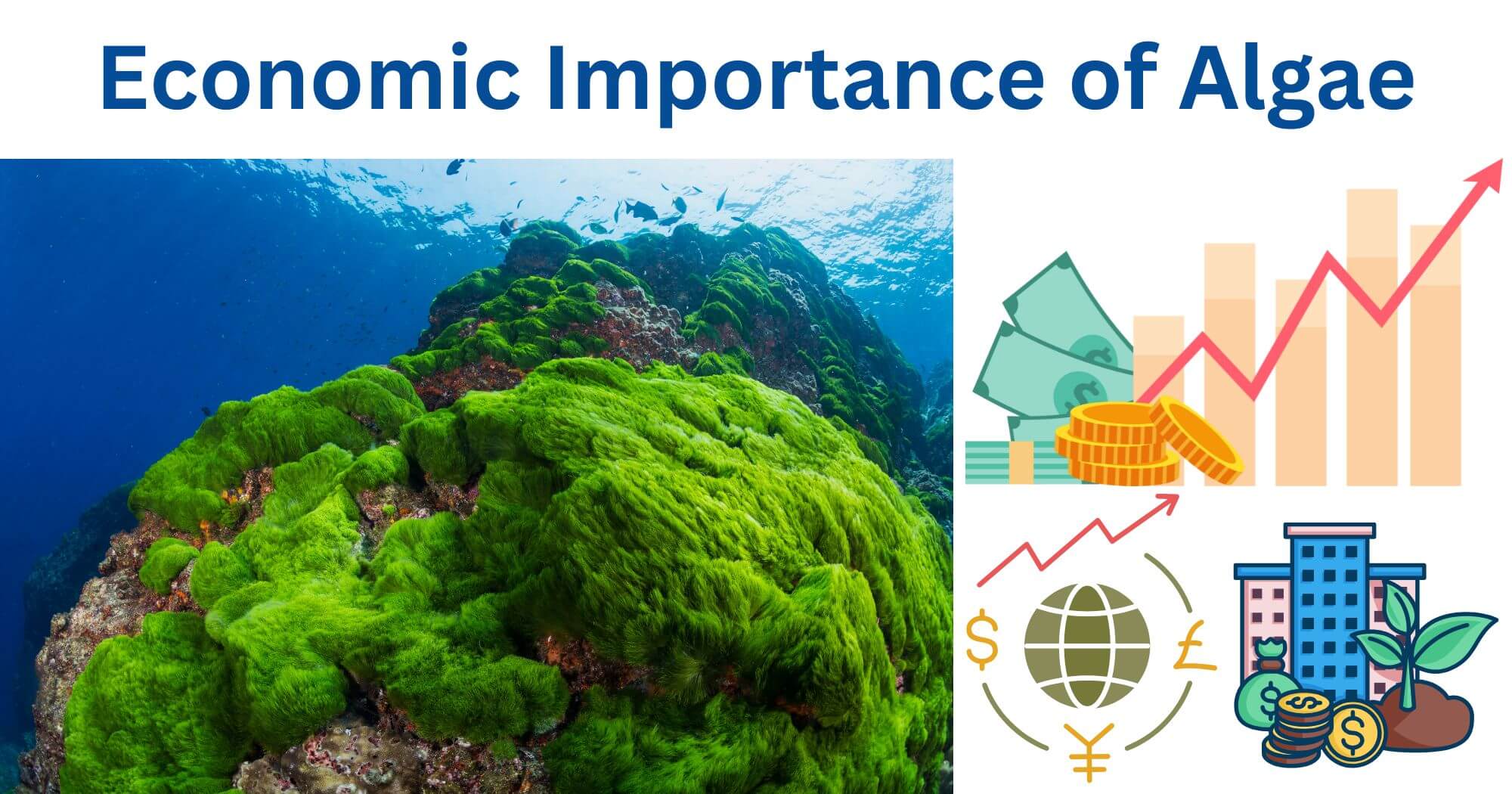Algae are an incredibly diverse group of photosynthetic organisms present in various aquatic ecosystems, including freshwater and marine environments, ranging from microscopic to large seaweeds. Historically underutilized organisms are now recognised for their potential economic importance. Algae are economically and environmentally friendly alternatives in agriculture, food, industry, environmental management, and animal husbandry.

Economic Importance of Algae in agriculture
Algae are valuable as biofertilizers and soil conditioners. Several algae such as Sargassum, Ascophyllum nodosum, and others are commonly used to form biofertilizers to enhance soil fertility. The algal products are rich in macro and micro nutrients including elements such as Nitrogen, Potassium, Iron, Zinc, etc., and also contain bioactive compounds such as Auxin, Cytokinin, and Gibberlins that promote plant growth.
The application of algal fertilizers improves soil structure, enhances water retention, and increases microbial activity thereby reducing dependency on synthetic fertilizers. They are environmentally friendly thus preventing the leaching of harmful chemicals and are sustainable in nature.
Algae as food
In many cultures, especially in countries of Southeast Asia, seaweeds are an integral part of their cuisine. Species like Porphyra, Laminaria, and Undaria are consumed for their rich umami flavor and excepotional nutritional proprerties these seeweeds are rich in calories and high in vitamins, minerals and polysaccharides that support gut health.
These algae also contain bioactive compounds such as phlorotannins, and fucodians etcwith antioxidant and anti-inflammatory properties making them valuable components of functional foods. The global market for edible seaweeds is is increasing which is one of the important aspects of algae.
Algae as nutrients
Microalgae such as Spirulina and Chlorella are widely used as dietary supplements and are rich in proteins, essential amino acids, antioxidants, omega-3 fatty acids, and beta carotene. These microalgae are considered as superfoods and their cultivation requires minimal freshwater making them a sustainable source of nutrition. Algal supplements are relevant in addressing malnutrition, and micronutrient deficiencies in developing regions.
Industrial applications of algae
One of the most commercially important uses of algae is the production of agar, carrageenan, and alginates. These hydrocolloids are extracted mainly from red algae Gelidium and Gracilaria and brown algae such as Macrocystis and Laminaria. These substances are widely used as stabilizing agents, thickening, and gelling agents in cosmetics, foid and pharmaceutical industries.
Agar is one of the essential culture mediums used in laboratories, whereas carrageenan is used in ice creams, yogurt, and dairy products to improve texture.
Algae as biofuels
Algae are nowadays used for the production of biofuels due to their high lipid content and high growth rates, they are considered the potential feedstock for third-generation biofuels. Under nutrient-starved conditions, microalgae can be processed into biodiesel, bioethanol, and biogas. Algal biofuels do not compete with the food chain and can be grown in non-arable land using wastewater.
Large-scale commercialization remains restricted by the high cost of production, continued improvements in genetic engineering, and technologies in developing different photobioreactors and harvesting methods are likely to improve feasibility. Algal biofuels are effective in reducing greenhouse emissions and dependence on fossil fuels.
Algae in environmental management
Algae are used extensively in wastewater treatment. They take in heavy metals, surplus nutrients, and organic contaminants through bioremediation which helps in cleansing industrial and municipal effluents. Algal species such as Chlorella, and Scendesmus are effective in removing impurities and decreasing biological oxygen demand (BOD).
Algal treatment helps in providing inexpensive and sustainable options compared to traditional processes. Biomass produced during the treatment can be used for the production of biofertilizer or biofuel, helping to achieve a circular economy.
Algae in carbon sequestration and climate change mitigation
Photosynthetic algae are important as carbon sinks, sequestering atmospheric CO2 and producing oxygen. By integrating algal contribution with carbon-emitting industries, it is possible to capture CO2 emissions and convert them into valuable biomass.
This makes algae a critical component in climate change mitigation measures. Macroalgal reforestation can be considered a nature-based solution to balance carbon footprints and revive marine ecosystems.
Algae in medicine- Algae contains various bioactive molecules which include different polysaccharides, peptides, alkaloids, and polyphenols with antimicrobial, antiviral, anti-inflammatory, and anticancer activities. These are widely used in the production of different medicines.
Medications derived from marine sources like Cytarabine, an anticancer drug originally harvested from red algae, are typical of the untouched potential of pharmacology in alga. Nowadays, research focusing on marine biotechnology still goes on to research algae for developing new drugs with a specific interest in treating antibiotic-resistant diseases and incurable diseases.
Economic Importance of Algae in the cosmetic industry
In cosmetic industries, algae are highly used for their anti-aging and hydrating properties. Some algal extracts are used in serums, creams, and sunscreens for their high contents of vitamins, amino acids, and antioxidants. The bioactive compounds present in these preserve skin elasticity, lower inflammation, and guard against damage by UV.
Algae as livestock nutrition
Algae are emerging as popular animal feed additives, with a rich nutritional value that helps in promoting growth, immunity, and reproductive performance. Adding algal biomass to livestock diets also decreases methane production by ruminants which is one of the important environmental issues of livestock production.
Spirulina is one of the important algae used in livestock diets due to its excellent digestibility and nutrient density.
Economic Importance of Algae in Aquaculture
Microalgae are used as larval food for fish, mollusks, and crustaceans in aquaculture. Some algal species such as Isochrysis and Tetraselmis are rich in lipids and vitamins that are necessary for the proper growth of aquatic organisms. Algae also improve the quality of water by removing nitrogenous waste, thus making a more sustainable aquaculture system.
Economic Impacts of algal cultivation
Algal cultivation is one of the fastest-growing sectors in marine regions. According to FAO, in 2022, total seaweed production across the world exceeded 35 million tonnes with China, Indonesia, South Korea, and the Philippines being the key producers. Seaweed is cultivated for both consumption and industrial harvesting.
Algal cultivation creates jobs and livelihoods in coastal and rural areas. It is labor-intensive, low-tech, and hence affordable for small farmers and cooperatives.
Moreover, seaweed cultivation has social impacts, such as empowering women in local economies and creating opportunities for education concerning marine sciences and entrepreneurship.
Prospects in algal cultivation
With advances in genetic engineering, synthetic biology, and cultivation methods, algae is finding new applications. Scientists are focused on the development of high-yielding microalgae, and lowering the cost of production. Algae are now being used in nanotechnology, bioplastics, biopesticides, and nutraceuticals.
As the bioeconomy expands, investments in algal technologies from both the public and private sectors will likely escalate. Interdisciplinary collaboration and encouraging policy environments will be essential to realizing the entire economic potential of algae.
Conclusion
Algae represent an enormous resource that lies at the nexus of ecology, economy, and innovation. They contribute to enhancing the productivity of agriculture, and different industries and offer sustainable solutions in the fields of energy, medicine, and environment. The economic importance of algae is enormous and far-reaching. As the science is emerging, algae are well set to be pivotal in meeting worldwide challenges of food security, energy needs and climate change and hence becoming a support for the bioeconomy of the 21st century.
References
- Wells, M. L., Potin, P., Craigie, J. S., Raven, J. A., Merchant, S. S., Helliwell, K. E., Smith, A. G., Camire, M. E., & Brawley, S. H. (2016). Algae as nutritional and functional food sources: revisiting our understanding. Journal of Applied Phycology, 29(2), 949–982. https://doi.org/10.1007/s10811-016-0974-5
- Abdel-Raouf, N., Al-Homaidan, A. A., & Ibraheem, I. B. M. (2012). Agricultural importance of algae. ResearchGate. https://www.researchgate.net/publication/282791348_Agricultural_importance_of_algae
- Tavares, J. O., Cotas, J., Valado, A., & Pereira, L. (2023). Algae food products as a healthcare solution. Marine Drugs, 21(11), 578. https://doi.org/10.3390/md21110578
- Miciński, J., Chwastowska-Siwiecka, I., & Miciński, J. (2023). Characteristics and applications of marine algae in the agri-food industry and animal nutrition. Journal of Elementology, 3/2023. https://doi.org/10.5601/jelem.2023.28.3.3044
- El-Beltagi, H. S., Mohamed, A. A., Mohamed, H. I., Ramadan, K. M. A., Barqawi, A. A., & Mansour, A. T. (2022). Phytochemical and potential properties of seaweeds and their recent applications: a review. Marine Drugs, 20(6), 342. https://doi.org/10.3390/md20060342
- Samoraj, M., Çalış, D., Trzaska, K., Mironiuk, M., & Chojnacka, K. (2024). Advancements in algal biorefineries for sustainable agriculture: Biofuels, high-value products, and environmental solutions. Biocatalysis and Agricultural Biotechnology, 58, 103224. https://doi.org/10.1016/j.bcab.2024.103224
- Bhateria, R., & Dhaka, R. (2014). Algae as biofuel. Biofuels, 5(6), 607–631. https://doi.org/10.1080/17597269.2014.1003701
- Sharma, P., & Sharma, N. (2017). Industrial and Biotechnological Applications of Algae: a review. Journal of Advances in Plant Biology, 1(1), 1–25. https://doi.org/10.14302/issn.2638-4469.japb-17-1534
- Farghali, M., Mohamed, I. M. A., Osman, A. I., & Rooney, D. W. (2022). Seaweed for climate mitigation, wastewater treatment, bioenergy, bioplastic, biochar, food, pharmaceuticals, and cosmetics: a review. Environmental Chemistry Letters, 21(1), 97–152. https://doi.org/10.1007/s10311-022-01520-y
- Zhang, L., Liao, W., Huang, Y., Wen, Y., Chu, Y., & Zhao, C. (2022). Global seaweed farming and processing in the past 20 years. Food Production Processing and Nutrition, 4(1). https://doi.org/10.1186/s43014-022-00103-2
- Fisheries, N. (n.d.). Seaweed: The Miracle Macroalgae with Major Economic and Environmental Value. NOAA. https://www.fisheries.noaa.gov/podcast/seaweed-miracle-macroalgae-major-economic-and-environmental-value
